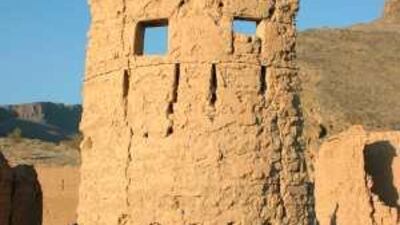SAMAIL, OMAN // Historians are urging Oman to include privately owned ruins, crumbling in rural areas, in the government's preservation programme to stop the erosion of the country's heritage. The sultanate spends 25 million rials (Dh249.5m) a year renovating and maintaining such historical buildings as forts, mosques and watchtowers all over the country, but the programme does not include privately owned buildings in abandoned villages.
In towns like Tanuf, Bid Bid and Barakat Mawz in the Al-Dakhaliya region, as well as towns in Dhofar, some ruined buildings lie in isolation, abandoned by descendents now living in modern villas. Most of them are severly damaged, and if they disappear, so will the last glimpse of Oman's rich heritage. Historians say some of the ruins are 700 years old and were occupied by noted Omanis who shaped the history of the country.
"These houses were occupied by dignitaries of the areas and preserving them will help make the residents proud of their heritages," Mohammed al Siyabi, a historian based in Samail, a small town about 150km from Muscat, said. "The government should not allow them to crumble just because they are owned by the descendants of the previous owners. If they go, then a large chunk of our heritage goes as well."
By way of example, Mr al Siyabi cited the houses of Ahmed bin Majid and Ahmad bin Naaman that are now lost forever. Bin Majid was a sailor who helped Vasco da Gama, the Portuguese explorer, find his way from Africa to India in 1499. Bin Naaman was the first Arab envoy sent on a goodwill journey to the United States, in 1833 by the sultan of Oman. But government officials said the preservation programme managed by the ministry of national heritage and culture did not have the jurisdiction of renovating privately owned houses.
"We only manage the state-owned old buildings and we cannot interfere with private areas no matter how old they are unless the owners of these ruins are willing to hand over the ownership to the government. "We cannot spend state money to renovate private houses," Said al Farsi, the head of the ministry's planning unit, said. In Nizwa, just 400 metres from the foot of the massive citadel built in the 17th century by former rulers of Oman, are ruins that, according to one of the descendants of the houses, were inhabited by the town's traders 500 years ago. They say the ruins are the reason the Al-Ya'arubi imams built the fort because of the thriving trade of the time.
"One of the ruins was a home of my family for six generations. The last of the inhabitants moved out just 30 years ago when it was too uneconomical to maintain the houses. That was the beginning of the decay and abandonment of the village," Salim Yousuf, a 71-year-old silversmith in Nizwa, said. Some observers are questioning how people like Mr Yousuf could afford to build modern two-storey villas just a kilometre away from the old ruins but do not have the money to repair the homes of their ancestors.
"The majority of these people are either well-to-do businessmen or well-paid civil servants who prefer to live in luxury rather than in cramped and ancient little houses. "They can afford to repair their ancestral homes but want government grants to do it for them. They would rather watch local history crumbling down than spend their money," said Khamis Fraish, a retired gatekeeper of the Bibi Maryam mausoleum at Qalhat, a town near Sur, in the Eastern region.
Some companies help the preservations of local ruins, such as the mausoleum, a site that does not fall under the government grant nor is claimed by any private owner. "Out of a social responsibility programme, we donated money for the repair of this mausoleum because we produce gas from the town and we would like the locals to be proud of their heritage. "But we don't do the privately owned ruins for obvious reasons," Nasser al Kindy, head of corporate communications of Qalhat LNG, said.
salshaibany@thenational.ae

